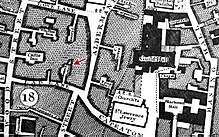Swan with Two Necks (London)


The Swan with Two Necks was a hostel and carriage station in the City of London that was one of the main departure points for travel from London to the north of England before the advent of railways. It later became a transshipment point for goods and parcels for the rail freight forwarder and transporter Chaplin & Horne.
location
The Swan was in a back yard on the north side of Lad Lane, not far from the intersection of Milk Street and Aldermanbury and Cateaton Street . Lad Lane and Cateaton Street became Gresham Street in 1845.
history
Before the advent of the railways, the Swan was one of the main departure points for travel from London to the north of England. John Taylor wrote in his Carriers Comographie (1637):
“The Carriers of Mancheſter, doe alſo lodge at the two neck'd Swan in Lad lane (betweene great Woodſtreet, and Milk-ſtreet end) they come every ſecond Thurſday: alſo there do lodge Carriers that doe paſſe through various other parts of Lancaſhire . ”
“The wagons from Manchester also stay in the double-necked swan in Lad Lane (between the great Wood Street and the end of Milk Street). They arrive every second Thursday: carters who travel through other parts of Lancashire also stay here. "
Around 1835 Swan came into the possession of the Kent driver William Chaplin (1787–?), Who built up a large haulage company with 1200 horses. In 1835 he operated 68 carts with 1,800 horses and employed 2,000 men. The hostels he ran also included Spread Eagle on Gracechurch Street , Cross Keys, and White Horse on Fetter Lane . He has been called "perhaps the greatest wagon entrepreneur who ever lived".
Chaplin sold most of his horses to invest in the railroad, and the Swan closed around 1860. It was replaced by a new building that was used to handle goods and packages for the rail freight forwarder and transporter Chaplin & Horne. The British Almanac of 1862 wrote:
“One of the most remarkable recent buildings in the City for its size and constructive features occupies the site of the well-known Swan-with-two-Necks, in Gresham Street. It is built for Messrs. Chaplin and Horne, the railway carriers, and has a frontage of nearly 100 feet, a depth of 150 feet, and a height of 64 feet above the pavement, while beneath are warehouses and extensive stabling. The front has a solid architectural character, in keeping with the purposes to which the building is to be applied. The ground floor, of Portland stone, rusticated, rests on a granite basement, while the three upper stories are of brick with stone dressings, a massive cornice crowning the whole. The architect was Mr. W. Tite, MP; the cost has been a little under 40,000l "
“One of the most notable buildings in the City for its size and design features is the site of the well-known Swan with two Necks on Gresham Street. It was built for Messrs. Chaplin and Horne, the rail freight forwarders, and has a front of almost 30 meters and a depth of 45 meters and a height of 19.5 meters above the road, with storage rooms and extensive stables in it. The front has a solid architectural character that is in keeping with the purposes for which the structure was designed. The Portland stone first floor sits on a granite plinth, while the top three floors are brick with stone ornamentation, and a solid cornice crowns the whole. The architect was Mr. W. Tite , MP; the costs were a little under 40,000l. "
A business directory from 1869 listed the Swan as "the receiving point for goods for the railway companies Great Eastern, London & South Western, South Eastern, London, Brighton & South Coast & London, Chatham & Dover". An advertisement for Chaplin & Horne from 1874 makes it clear that the Swan with two Necks was just one of the company's several depots. Chaplin & Horne competed with Pickfords for much of the 19th century , which Chaplin & Horne eventually took over, and the Swan at 57 Gresham Street became a depot of Pickfords and their main office.
Web links
- Swan with Two Necks, 41 Gresham Street, Cheapside, St Lawrence Jewry, City of London . UK Pub history research and London historical street directory.
- Grace's Guide - Pickfords
supporting documents
- ^ Royal Mails preparing to start for the west of England . Retrieved February 6, 2018.
- ↑ Christopher Hibbert, Ben Weinreb, John Keay, Julia Keay: Gresham Street . In: The London Encyclopaedia . 3. Edition. Macmillan, London 2011, ISBN 978-0-230-73878-2 , pp. 357 ( books.google.de - reading sample).
- ^ Walter Thornbury, Edward Walford: Old and new London. A narrative of its history, its people, and its places . tape 1 . Cassell, London, p. 374 ( Textarchiv - Internet Archive ).
- ↑ Map of Early Modern London ( mapoflondon.uvic.ca ) Retrieved February 6, 2018.
- ^ Harry Hanson: The Coaching Life . Manchester University Press, Manchester / Dover, NH, USA 1983, ISBN 0-7190-0930-8 , pp. 149 ( books.google.com ).
- ↑ Philip Norman: London vanished and vanishing . Adam and Charles Black, London 1905, p. 105 ( Textarchiv - Internet Archive ).
- ^ Finchley: Economic history. British History Online. Retrieved February 6, 2018.
- ^ The British Almanac . Knight & Co., London 1862, p. 275 ( Textarchiv - Internet Archive ).
- ^ The Railway and Commercial Gazetteer of England, Scotland, and Wales: Comp. from Official Sources . McCorquodale & Company, Limited, London 1874, p. 423 ( books.google.com ).

